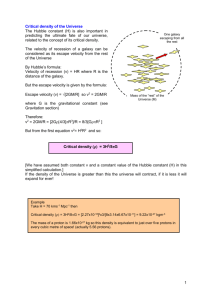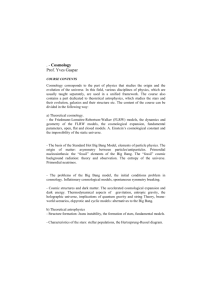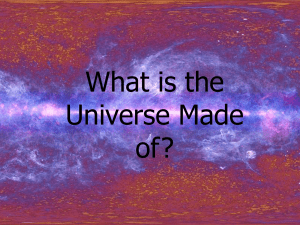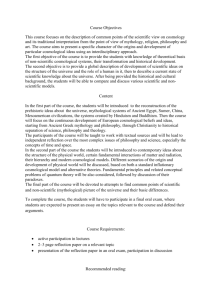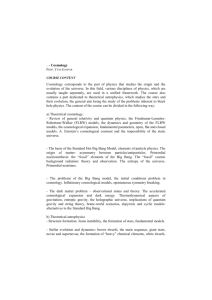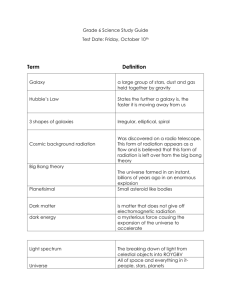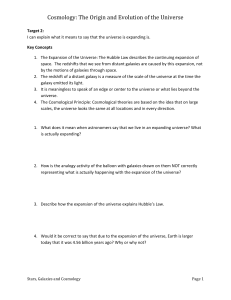AY145 Topics in Astrophysics
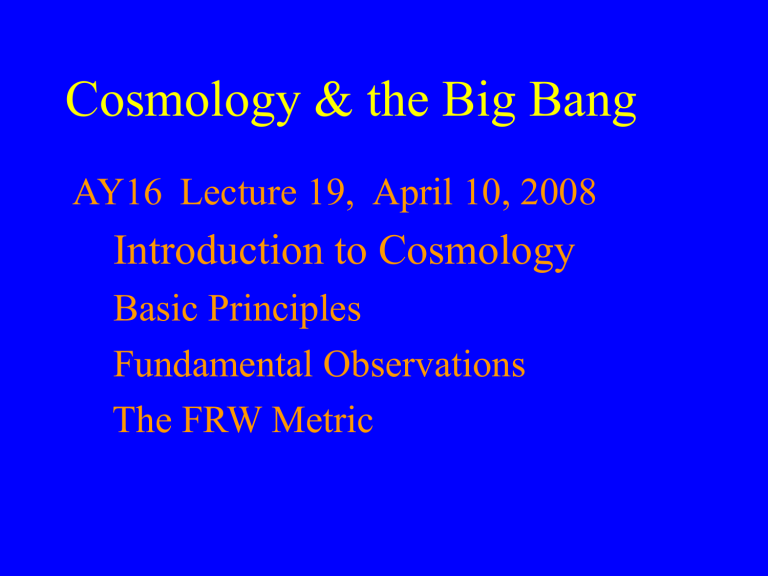
Cosmology & the Big Bang
AY16 Lecture 19, April 10, 2008
Introduction to Cosmology
Basic Principles
Fundamental Observations
The FRW Metric
“My husband adheres to the Big
Bang theory of creation.”
COSMOLOGY
The BIG Picture!
The cosmological model dominates much of extragalactic astronomy, in fact much of astronomy & astrophysics, even physics.
What is Cosmology? “The study of the large scale structure & evolution of the Universe”
What is Cosmogony? “The study of the origin of observable structures”
Cosmology is perhaps the oldest real science.
Its tied to our
“World View.”
Changing Worldviews
Age Universe
----------------------------------------------------------------------------------
10,000 years BC --The Valley you lived in
1,000 years BC --Your Kingdom
300 years BC --The Mediterranean
(for Egypto-Greco-Romans, at least!)
100 years AD --The Earth + Celestial Sphere
400 years ago --The Solar System
100 years ago --The Milky Way
75 years ago ---
The “Modern” Universe
(2 Billion Light -Years in *radius*)
Today --An Infinite Universe
(the visible part has a Radius of ~15 Gly)
A Brief History of Extragalactic
Astronomy:
~ 1750 Early Rumblings of “Island Universes” from I. Kant, T. Wright, P. Laplace.
This seems to have been forgotten soon after.
1800’s Catalogs of Things but no understanding.
de la Caille, Messier, Herschel
3
, Dreyer
William, Caroline & John
~ 1875 The Discovery of the Galaxy --- Kapteyn’s
Universe
1910 Removal of the Solar-Centric view
1900-1920 Shapley and the Great Debate
1907 Bohlin --- M31 Parallax
1918 Van Maanen --- M31 Parallax
1885 S Andromeda = SN1885a large reflectors + photographic plates
1920 The Shapley-Curtis debate
Shapley + Globular Clusters + Cepheids
1924 Hubble & the Hooker --- NGC 6822
Cepheids, eventually M31 Cepheids
1910-1930 Theory! Einstein, Friedmann, deSitter, Lemaitre, Tolman, Robertson …
1922 Opik’s M31 Mass-to-Light ratio
L = 4πr
2
GMm/r = ½ mv 2
M = ½ v 2 r/G, so M/L = ½ v
2
1 1
G
4πD and Opik estimated D of M31 at 450 kpc.
1929 Hubble (+Slipher)
Velocity-Distance
Law
1930’s Hubble’s Classification Scheme for
Galaxies (Tuning Fork Diagram)
N.B. Absolutely necessary but wrong interpretation, set galaxy evolution back 20 years!
Hubble’s Galaxy Counts (Humason)
1937 Zwicky & Smith DARK MATTER
1940’s Galactic Dust, Stellar Populations,
Hubble Diagram
1948 Gamow & the Hot Big Bang
1950’s deVaucouleurs’ Local “Supergalaxy”
Rubin: Flows
Dicke: CM
HMS Velocities + Hubble Diagram
Baade & Sandage: H
0 revisions
Minkowski: Radio galaxies
1960’s The Hubble Constant Debate
Tinsley: Stellar Evolution
Galaxy
Evolution
Greenstein & Schmidt: Quasars
Arp: Peculiar Galaxies
Spinrad &Taylor : Population Synthesis
Page: Galaxy Masses
1970’s Stability & Halos
Starbursts
H
0
!!! q
0
!!!
First Feeble Redshift Surveys
CMB Dipole
Galaxy Clusters & X-Rays
Gravitational Lenses
Galaxy Formation
1980’s Large-Scale Structure
Large Scale Flows & Cold Dark Matter
Galaxy Counts
H
0
!!!!
IRAS & Dusty Starbursts
1990’s COBE: 2.723 K + fluctuations
Biased galaxy Formation
Unified AGN Models
Λ!!!!!
Concordance Cosmology
HST and galaxy evolution
2000+ The Cosmic Web
Reionization
First Light
COSMOLOGY is a modern subject:
Today based on Principles & Observables
The basic framework for our current view of the Universe rests on ideas and discoveries
(mostly) from the early 20 th century.
Basics:
Einstein’s General Relativity
The Copernican Principle
Fundamental Principles:
•
Cosmological Principle : (a.k.a. the
Copernican principle). There is no preferred place in space --- the Universe should look the same from anywhere
The Universe is HOMOGENEOUS and
ISOTROPIC. we believe this is true to zeroth order
(i.e. on large scales, yes, on small scales, no)
A variant of the CP is
• The Perfect Cosmological Principle :
The Universe is also the same in time.
The STEADY STATE Model (XXX it’s demonstrably wrong)
• The Anthropic Cosmological Principle :
We see the Universe in a preferrred state (time etc.) --- when Humans can exist.
the ACP is almost the opposite of the PCP.
it leads to the Goldilocks Universe:
Not too hot, Not too cold
Not too dense, Not too empty
Not too young, Not too old….
•
Relativistic Cosmological Principle :
The Laws of Physics are the same everywhere and everywhen.
(!!!) absolutely necessary, often assumed and forgotten. (!!!)
Fundamental Observations
:
• The Sky is Dark at Night (Olber’s P.) this implies there must be some limit to the observable Universe.
•
The Universe is generally Expanding
It’s not static.
galaxies appear to be moving away from us --- and each other.
Olber’s Paradox
Hubble’s Discovery of Expansion
•
The Universe is Homogeneous on large scales --- there exists an almost isotropic microwave background (the CMB) of T~3K a.k.a. relic radiation
•
The Universe is not Empty. It has stuff in it, stuff consistent with a hot origin (the
Universe has a temperature), i.e. contents consistent with nuclear physics operating in an initially hot, dense medium
COBE Fluctuations
d t/t
< 10
-5
, i.e. much smoother than a baby’s bottom!
Observational Cosmology
consists of taking these bases to build a more detailed picture of the structure and evolution of the Universe.
Sometimes to (1) Feed Theorists
(2) Kill Theories
(3) Explore
generally support Gamow’s hot big bang model
COSMOLOGICAL FRAMEWORK:
The Friedmann-Robertson-Walker
Metric
+
The Cosmic Microwave Background
= THE HOT BIG BANG
The Big Bang
WRONG!
WRONG!!!
WRONG ??
T
THE TRUTH BEHIND THE
BIG BANG THEORY
How my wife describes my job!
RIGHT
!
Mathematical Cosmology
The simplest questions are Geometric.
How is Space measured?
Standard 3-Space Metric: ds
2
= dx
= dr
2
2
+ dy
2
+ r
2 d θ
2
+ dz
2
+ r
2 sin
2
θ d f 2
In Cartesian or Spherical coordinates in
Euclidean Space.
Now make our space Non-Static, but
“homogeneous” & “isotropic”
ds
2
= R
2
(t)(dx
2
+ dy
2
+ dz
2
)
And then allow transformation to a more general geometry (i.e. allow non-
Euclidean geometry) but keep isotropic and homogeneous:
ds
2
= (1+1/4kr
2
)
-2
(dx
2
+dy
2
+dz
2
)R
2
(t) where r
2
= x
2
+ y
2
+ z
2
, and k is a measure of space curvature.
Note the Special Relativistic
Minkowski Metric ds
2
= c
2
dt
2
– (dx
2
+dy
2
+ dz
2
)
So, if we take our general metric and add the 4 th
(time) dimension, we have : ds
2
= c
2 dt
2 –
R
2
(t)(dx
2
+dy
2
+ dz
2
)/(1+kr
2
/4) or in spherical coordinates and simplifying, ds
2
= c
2 dt
2 –
R
2
(t) [dr
2
/(1-kr
2 r
2 ( d
)
2
+
+ sin
2 d f 2 )] which is the (Friedmann)-Robertson-Walker
Metric, a.k.a. FRW
• The FRW metric is the most general, non-static, homogeneous and isotropic metric. It was derived ~1930 by Robertson and Walker.
R(t),
the Scale Factor
,
is an unspecified function of time (which is usually assumed to be continuous) and k = 1, 0, or -1 = the Curvature Constant
For k = -1 or 0, space is infinite
K = +1
Spherical c < p r
K = -1
Hyperbolic c > p r
K = 0
Flat c = p r
Consider Expansion in an Isotropic
Universe
a(t) = Universal Expansion factor
Expansion is self-similar and produces a change in the frequency of received radiation. If t
0
= now, here, observed & t the time at which light is emitted from a
1
= distant object in the scaled universe: a(t)δt t
0
+Δt
0 t
0 t e
+Δt e t e
= t
1
1/Δt e
= υ
1
υ
0
υ
1 frequency of emitted radiation a(t
= = a(t
0
1
) λ
) λ
0
1 so
υ
1
, λ
1
= lab or rest frequency/wavelength and
υ
0
, λ
0
= observed frequency/wavelength and if we define z ≡ redshift =
λ
0
– λ
1
λ
0
Then 1 + z
R(t
0
) a(t
0
)
= =
R(t
1
) a(t
1
)
For small z we can interpret this “redshift” in terms of a Doppler shift, cz = v, or Doppler velocity. For small Δt, if r
0 us, the observer), we have:
= 0 (set origin to r
1
= c (t
0
- t
1
)/R(t
0
) d = r
1
R(t
0
) = c(t
0
-t
1
) the distance and thus cz = c(t
0
– t
1
)
1 dR(t
1
)
R(t
0
) dt
so v = cz = H
0 d where H
0 dR(t
0
) 1 dR(t
= ≈ 1
) 1 dt R(t
0
) dt R(t
1
) is the definition of
Hubble’s Constant
.
Note that this is true for small z only. This formula for distance is NOT subject to special relativity. The convention is to quote apparent velocities as v = cz.
The apparent (radial) velocity of any object is made up of three parts v = v
H
+ v
P
+ v
G v
H
= the cosmological stretching of the metric, a.k.a. the Hubble Flow v
P
= the component of the “peculiar” velocity w.r.t. the Hubble Flow that is an actual space velocity.
v
P is Doppler, so computations of dynamical properties like cluster velocity dispersions that result from correction.
v
P do require the (1+v 2 /c 2 )
–1/2 v
G
= the gravitational redshift, usually tiny
Expansion Age & Hubble Distance
The Hubble Constant has units of inverse time; its actually also a measure of the expansion age of the Universe:
τ
H
= H
0
-1 = 9.78x10
9 h -1 years = 3.09x10
17 h -1 s where H
0
= 100 h km/s/Mpc
And the Hubble Distance is
D
H
= c/H
0
= 3000 h -1 Mpc = 9.26x10
25 h -1 m
What about the scale factor R(t)?
R(t) is specified by
Physics
we can use Newtonian Physics (the
Newtonian approximation) but now General
Relativity holds.
Start with Einstein’s (tensor) Field Equations
G
u
= 8pT
n
+ L
g
u
G
u
=
R
n
- 1/2
g
u
R
and
Where
T
n is the Stress Energy tensor
R
n is the Ricci tensor
g
u is the metric tensor
G
u is the Einstein tensor and R is the scalar curvature
R
n
- 1/2 g u
R =
8pT
n
+ L
g
u is the Einstein Equation
The vector/scalar terms of the Tensor Field
Equations give the linear form
Einstein’s Equations:
(dR/dt)
2
/R
2
+ kc
2
/R
2
= 8 p
G e/3
c
2
+
L c
2
/3 energy density CC
2(d
2
R/dt
2
) /R + (dR/dt)
2
/R + kc
2
/R
2
=
-8 p
GP
/
c
3
+
L c
2 pressure term
And Friedmann’s Equations
:
(dR/dt)
2
= 2GM/R +
L c
2
R
2
/3 – kc
2
kc
2
= R
o
2
[(8
p
G/3)
r o
– H
o
]
2 if
L
= 0 (no Cosmological Constant) or
(dR/dt)
2
/
R
2
- 8 p
G r o
/3 =
L c
2
/3 – kc
2
/R
2 which is known as Friedmann’s Equation
Note that if we assume Λ = 0, we have
(d
2
R/dt
2
)/R =
4πG
3
(ρ + 3P) and in a matter dominated Universe, ρ >> P
So we can define a critical density by combining the cosmological equations:
.
ρ
C
3 R
2
= =
8πG R
2
3H
0
2
8πG
And we define the ratio of the density to the critical density as the parameter
Ω ≡ ρ/ρ
C
For a matter dominated, Λ=0 cosmology,
Ω > 1 = closed
Ω = 1 = flat, just bound
Ω < 1 = open
There are many possible forms of R(t), especially when Λ and P are reintroduced. Its our job to find the right one!
Λ = 0
Some of possible forms are:
Big Bang Models :
Einstein-deSitter k=0 flat, open & infinite expands
Friedmann-Lemaitre k=-1 hyperbolic “
“ “ k=+1 spherical, closed finite, collapses
Leimaitre Λ ≠0 k=+1 spherical, closed finite, expands
Non-Big Bang Models
Eddington-Lemaitre Λ≠0 k=+1 spherical, closed, finite, static then expands
Steady State k=0 flat, open, infinite, stationary deSitter k=0 empty, no singularity, open, infinite k =
H
0
2
(Ω
0
– 1) + 1/3 Λ
0 c
2
≡ Radius of Curvature of the Universe
R(t)
A Child’s Garden of Cosmological Models
F-L,0
E-L
EdS
SS,dS
L
F-L,C t
Harrison’s
Classes
Geometric:
Closed
Open
Kinematic:
Bang
Whimper
Static
Oscillating
Cosmology is now the search for three numbers:
• The Expansion Rate = Hubble’s Constant
= H
0
• The Mean Matter Density =
Ω
matter
• The Cosmological Constant =
Ω
Λ
Taken together, these three numbers describe the geometry of space-time and its evolution.
They also give you the Age of the Universe.
The best routes to the first two are in the
Nearby Universe:
H
0 is determined by measuring distances and redshifts to galaxies. It changes with time in real FRW models so by definition it must be measured locally.
W
(matter) is determined locally by
(1) a census, (2) topography, or (3) gravity versus the velocity field (how things move in the presence of lumps).
The cosmological constant is determined by measuring geometry on large scales --- e.g. by the supernovae Hubble Diagram (distance versus redshift)
Or by a difference technique, e.g. CMB shows us that the Universe is Flat, but Ω
M is only 0.3, so ……
Lookback Time
For a Friedmann-Lemaitre Big-Bang Model, the lookback time as a function of redshift is
τ
L
= H
0
-1 ( z
1+z
)
for q
0
=0; Λ=0
= 2/3 H
0
-1
[1 – (1 + z) -3/2 ] for q
0
=1/2, Λ=0
Cosmological Age Calculation
For models w/o a Cosmological Constant, for q
0
= 0 t
0
= H
0
-1 q
0
= ½ t
0
= (2/3)H
0
-1 q
0
> ½ t
0
= H
0
-1
(1/(1-2q
0
) + ..) where q
0
=
W
/2 (if
L
= 0)
For the general case (with a CC), the full form is: t
0
= -H
0
-1 ∫ 0
(1+z)
[
(1+z)
∞
(
W
L z(z+2))
]
2
(
W m z+1) –
-1/2 dz and a good approximation is t
0
=
(2/3)
H
0
-1
sinn
-1
[(|1-
W a
|/
W a
)
1/2
]
/ |[1-
W a
]|
1/2
Where
W a =
W matter
-0.3*
W total
+ 0.3
and sinn
-1
= sinh
-1
= sin
-1 if if
W a </= 1
W a > 1
(from Carroll, Press and Turner, 1992)
Also, for a flat model with L, t
0
= (2/3)H
0
-1 W
L
-1/2 ln[(1+
W
L
1/2
) / (1-
W
L )
1/2
]
Classical Cosmological Tests
Use observations to test/measure the cosmological model:
Observables: Apparent magnitudes
Redshifts
Angular Diameters
Number Counts
Ages of Things (rocks, stars, star clusters)
(1) Magnitude vs Redshift (The Hubble Diagram)
(assume or find a standard candle)
1
1/2
0
-1 q
0
V magnitude (corrected)
(2) Counts vs Magnitude (Evolution?)
(3) Angular Diameter vs Redshift (Yardstick)
(4) Age Consistency (rocks vs expansion age)
(5) Density versus Redshift (galaxy evolution again)
